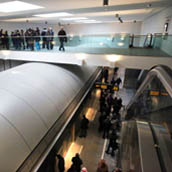Safe, reliable, beautiful, and completely driverless. Brescia’s new metro system, which will be inaugurated by the mayor and the town council on 2 March 2013, is the brainchild of a large Italian partnership between Ansaldo STS (prime contractor) and AnsaldoBreda, two Finmeccanica companies, and Astaldi. The group has produced a technological gem inspired by the driverless underground system of Copenhagen, Denmark, which has been operational since 2002 with much success and passenger satisfaction.
Con 17 stazioni, di cui 8 in galleria, 5 in trincea, 2 a raso e 2 in viadotto sopraelevato, la metropolitana di Brescia rappresenta un prestigioso “biglietto da visita” della città, che potrà godere di un moderno sistema di trasporto, particolarmente curato anche nell’estetica: accoglienti, confortevoli, accessibili e sicure anche per i non deambulanti ed i non vedenti, le stazioni hanno dimensioni ridotte, percorsi interni brevi e diretti, illuminazione diffusa, moderni sistemi di comunicazione, informazione e telesorveglianza; quelle in galleria presentano una “continuità spaziale” dalla superficie esterna, ricca di lucernari, fino al piano di banchina, grazie all’eliminazione del tradizionale mezzanino. L’apporto di luce naturale proveniente dall’esterno, dà al passeggero in attesa la possibilità di percepire cielo e spazi aperti esterni rafforzando la percezione di sicurezza.
With 17 stations, of which eight are in deep tunnels, five in subsurface tunnels, two at ground level, and two in elevated viaducts, Brescia’s metro represents a prestigious calling card for the city, which will be able to benefit from a modern transport system, where even aesthetic details were carefully considered. The stations are cosy, comfortable, accessible and safe for all passengers, including wheelchair users and the visually impaired; moreover, they are small, with short and direct internal passageways; well lit, and equipped with modern communication, information and video surveillance systems. Deep-tunnel stations will have “spatial continuity” with the outside, with plenty of skylights up to the platform, thanks to the removal of the traditional mezzanine. The flow of natural light from the outside allows waiting passengers to see the sky and open space, thus reinforcing their perception of safety.
The first operational stretch of line, between the terminus stations of Prealpino and S.Eufemia Buffalora, is 13.7 km. Of these, 6 km. is in a deep tunnel excavated with a tunnel boring machine in the central part of the line, 4.7 km. in subsurface tunnels, 1.3km. at ground level and 1.7 km. in elevated viaducts. The line, which runs from the North, underpasses via Triumplina, then turns near the stadium toward Ospedali Civili; it then goes through the historical centre, where there is an interchange station with the railway network, and continues to Brescia 2, turning into via Lamarmora. It then passes through Poliambulanza, and crosses the areas of San Polo and Sanpolino until it reaches the depot.
Driverless systems are operated through a central system, the control room, which makes it possible to monitor train operations throughout the day, providing passengers with continuous assistance.
There are many benefits compared with more conventional metro systems: vehicles and infrastructure are smaller, with the resulting reduction in investment; reduced staff costs thanks to automation (no drivers or station staff); a more frequent service and much greater rescheduling flexibility; cumulative delays during the day are automatically made up for; the frequency of trains is scheduled on the basis of traffic requirements, with an increase during rush hours and a reduction when there are fewer passengers; and extremely high safety levels due to the elimination of human error.
Press release of Ansaldo STS, 2 March 2013
